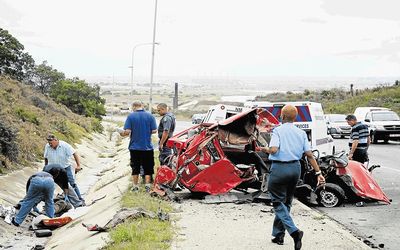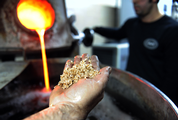Car firms in gear for safety with hi-tech features
by Mira Oberman,
2016-01-19 06:10:56.0
CAR makers are imagining a world in which nobody dies in car accidents and they say it is closer than most people think.
While they maintain that the real solution lies in self-driving cars, a host of hi-tech safety features are making drivers safer — and better — in the meantime.
"The long-term vision is that cars shouldn’t crash," says Volvo spokesman Jim Trainor.
Volvo — which has built its reputation on safety leadership — has set a goal that by 2020 nobody will be killed or seriously injured in its new cars.
The past decade has seen dramatic development by various car makers in the field of collision-avoidance technology. Blind-spot detectors now watch for oncoming vehicles, adaptive cruise controls reduce speed based on cars ahead, and camera systems warn drivers when they drift out of their lanes.
The key to making new safety features desirable to drivers is ensuring that they assist rather than irritate, Trainor says.
"If it false brakes too often, people get frustrated and they turn the system off," he says. "We need to calibrate the system so it gives the driver every last possible moment to take action."
In addition to accident avoidance, Volvo is developing systems that reduce injuries when crashes are inescapable. Among these is a rear impact mitigation system that senses if a car is approaching too quickly and preconditions the interior for impact by tightening seatbelts and engaging brakes.
Initially reserved for high-end luxury vehicles, the cost of safety technology is falling and finding its way into lower-priced cars.
The new Ford Fusion contains 20 driver-assistance technologies, including a pedestrian-detection system and a steering wheel that vibrates if a driver begins drifting from the lane.
"As we release more vehicles, I think you’ll anticipate a lot of migration across the line-up," says Ford spokesman John Cangany.
General Motors (GM) has a new rear-door monitor in its GMC Acadia crossover that reminds drivers to check the back seat for children before leaving the car. The safety feature will eventually be included in all of its models.
"Too many children are accidentally left behind in vehicles," says Mark Reuss, head of product development at GM.
The company is the first car maker to use the alert system and is working on technology that can detect if a child is left behind.
"Obviously, we want to protect our customers," says Rich Latek, who heads marketing for GM. "We’re really looking at a goal to end up with zero collisions and zero fatalities."
Toyota recently introduced a new suite of features called Safety Sense that will be offered on nearly all models by next year.
When first introduced on Lexus vehicles, it cost an additional $6,000. Toyota has now managed to bring the price down to between $300 and $630, says its spokesman Mike Kroll.
Despite the science fiction-like advancements in safety technology, a slew of scandals has undermined trust in the reliability of vehicles.
Last week, the first civil trial began in the US over a deadly ignition switch defect that GM hid from safety regulators for more than a decade, and is linked to at least 124 deaths.
Fiat Chrysler and Toyota have each become embroiled in scandal — and had handed millions upon millions of dollars in fines — over improperly handling or even covering up defects in millions of vehicles.
AFP

Car makers are developing new technologies with regards to reducing the number of accidents on the roads. Picture: WEEKEND POST
CAR makers are imagining a world in which nobody dies in car accidents and they say it is closer than most people think.
While they maintain that the real solution lies in self-driving cars, a host of hi-tech safety features are making drivers safer — and better — in the meantime.
"The long-term vision is that cars shouldn’t crash," says Volvo spokesman Jim Trainor.
Volvo — which has built its reputation on safety leadership — has set a goal that by 2020 nobody will be killed or seriously injured in its new cars.
The past decade has seen dramatic development by various car makers in the field of collision-avoidance technology. Blind-spot detectors now watch for oncoming vehicles, adaptive cruise controls reduce speed based on cars ahead, and camera systems warn drivers when they drift out of their lanes.
The key to making new safety features desirable to drivers is ensuring that they assist rather than irritate, Trainor says.
"If it false brakes too often, people get frustrated and they turn the system off," he says. "We need to calibrate the system so it gives the driver every last possible moment to take action."
In addition to accident avoidance, Volvo is developing systems that reduce injuries when crashes are inescapable. Among these is a rear impact mitigation system that senses if a car is approaching too quickly and preconditions the interior for impact by tightening seatbelts and engaging brakes.
Initially reserved for high-end luxury vehicles, the cost of safety technology is falling and finding its way into lower-priced cars.
The new Ford Fusion contains 20 driver-assistance technologies, including a pedestrian-detection system and a steering wheel that vibrates if a driver begins drifting from the lane.
"As we release more vehicles, I think you’ll anticipate a lot of migration across the line-up," says Ford spokesman John Cangany.
General Motors (GM) has a new rear-door monitor in its GMC Acadia crossover that reminds drivers to check the back seat for children before leaving the car. The safety feature will eventually be included in all of its models.
"Too many children are accidentally left behind in vehicles," says Mark Reuss, head of product development at GM.
The company is the first car maker to use the alert system and is working on technology that can detect if a child is left behind.
"Obviously, we want to protect our customers," says Rich Latek, who heads marketing for GM. "We’re really looking at a goal to end up with zero collisions and zero fatalities."
Toyota recently introduced a new suite of features called Safety Sense that will be offered on nearly all models by next year.
When first introduced on Lexus vehicles, it cost an additional $6,000. Toyota has now managed to bring the price down to between $300 and $630, says its spokesman Mike Kroll.
Despite the science fiction-like advancements in safety technology, a slew of scandals has undermined trust in the reliability of vehicles.
Last week, the first civil trial began in the US over a deadly ignition switch defect that GM hid from safety regulators for more than a decade, and is linked to at least 124 deaths.
Fiat Chrysler and Toyota have each become embroiled in scandal — and had handed millions upon millions of dollars in fines — over improperly handling or even covering up defects in millions of vehicles.
AFP





















Change: 1.19%
Change: 1.36%
Change: 2.19%
Change: 1.49%
Change: -0.77%
Data supplied by Profile Data
Change: -0.19%
Change: 0.69%
Change: 1.19%
Change: 0.00%
Change: 0.44%
Data supplied by Profile Data
Change: 0.62%
Change: 0.61%
Change: 0.23%
Change: 0.52%
Change: 0.12%
Data supplied by Profile Data
Change: -0.21%
Change: -1.22%
Change: -0.69%
Change: -0.51%
Change: 0.07%
Data supplied by Profile Data